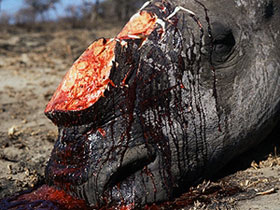Rhino hunting increased in Asia and Africa
The latest report by TRAFFIC (the network of wildlife trade control) and the International Union for Conservation of Nature (IUCN) said that rhino hunting is increasing worldwide.
 This urgent announcement was issued on December 3 by WWF (International Fund for Nature Protection).
This urgent announcement was issued on December 3 by WWF (International Fund for Nature Protection).
Accordingly, increased trafficking comes from the need to consume rhino horn in Asia and become more serious when hunting activities become more sophisticated.
The report also raised concerns regarding the diminishing amount of rhino, as well as the instability of some Sumatran rhino and rhino Gia and in Malaysia, Indonesia and Vietnam.
"These countries need to increase their efforts to better assess the status of their country's rhino populations, strengthen field law enforcement efforts - prevent territorial aggression or change. living rhino . to ensure the increase in the number of Sumatran and Gia rhino remains, and the remaining " , Dr. Bibhab Kumar Talukdar, Head of Asian Rhino Specialist Group IUCN / SSC said.
The report also said that since 2006, 95% of rhino poachers are occurring in Zimbabwe and South Africa.
Currently, the report has been submitted to the Convention on International Trade in Endangered Species of Wild Fauna and Flora (CITES) before the 15th session of the Convention on CITES Member States (Convention on National Trade The threat of threatened and endangered flora and fauna takes place in March next year, which highlights the decline in the effectiveness of law enforcement and the increase in intensity of hunting wildlife in Europe. Africa.
Most rhino horns removed from the African region were transferred to traditional medicine market in Southeast Asia, East Asia, especially in Vietnam and China. In addition, the report also expressed concern about the status of only one Gia rhino population in Vietnam.
The report was prepared by the IUCN and TRAFFIC Rhino Experts Group with the authorization of CITES. Data collection and reporting are partly funded by WWF and its partners.
- Rhino protection campaign
- Save the rhino's synthetic rhino horn
- South Africa combats rhino poaching with chips and DNA
- VN-South Africa is about to sign the MoU to prevent rhino horn trade
- Rhinos are killed more and more
- Mother died, the rhinoceros child refused to sleep alone
- In just a few years, the rhino will become extinct
- South Africa protects rhinos with reconnaissance aircraft
- The precious horned bird is more than ivory
- The piece of rhino horn and the man spirit
- Black rhinoceros was rarely born in the British zoo
- South Africa poisoned rhino horn
 Is the magnetic North Pole shift dangerous to humanity?
Is the magnetic North Pole shift dangerous to humanity? Washington legalizes the recycling of human bodies into fertilizer
Washington legalizes the recycling of human bodies into fertilizer Lightning stone - the mysterious guest
Lightning stone - the mysterious guest Stunned by the mysterious sunset, strange appearance
Stunned by the mysterious sunset, strange appearance